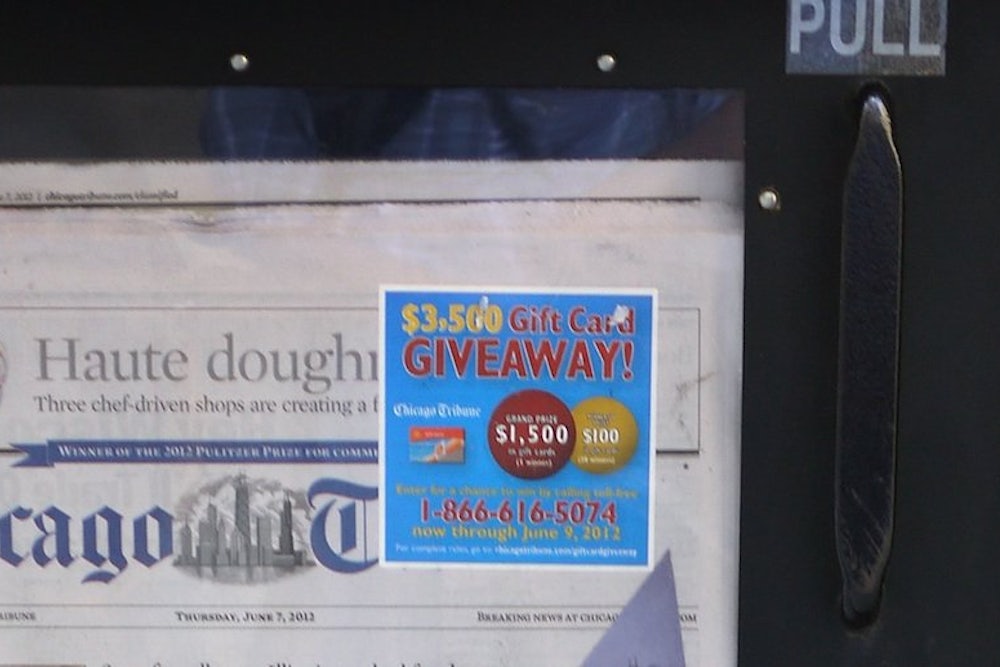Jeff Bezos recently shelled out $250 million for The Washington Post. But The New York Times is really the only serious newspaper left standing. When I say “serious,” I mean no disrespect to USA Today, which is better than its reputation, or The Wall Street Journal, which is better under Rupert Murdoch than most people expected. But only The New York Times is encyclopedic: It aspires to tell you everything you need to know before venturing out into the world each day. And it often succeeds.
Should we take it on? You and me? If there’s room for one serious general-interest national newspaper, there’s room for two. In fact, there already are two in a way, but nobody ever notices.
So here’s the plan. To start, you’ll need one Tribune Company. You know it: parent of the Chicago Tribune; bought Times Mirror, parent of the Los Angeles Times, in 2000. This may sound like a formidable requirement. You don’t find newspaper chains just sitting around in metal boxes on street corners, waiting to be bought or stolen. Well actually, in the case of Tribune, you do. In the past decade, virtually everyone has owned the Tribune Company for at least a bit. It has been in and out of bankruptcy and was owned for a while by Sam Zell, a man famous for hating newspapers and everything about them.
The New York Times, meanwhile, is the best newspaper in the world. Oh, come on, you know it is, irritating as that may be. Even those who prattle about Le Monde or The Guardian would choose The New York Times if they could have only one. The Times also has a plausible plan for the Internet, which it is deploying with modest success.
One thing the Times does not have (except of course in New York) is local news and information. It is creatively trying to bridge that gap through deals with local alternative media, but for most people, even Times lovers, The New York Times will always be a second read. You buy your local paper, and then, maybe, you buy the Times. (Unless, that is, your local paper is truly, truly dreadful: a caveat that couldn’t possibly apply to more than 75 percent of the country.)
The fact that the Times is a second read for many people is a major limit on the potential growth of its national edition. It’s hard enough to get people to read (and advertise in) one newspaper. Expecting them to buy two is probably expecting too much.
I am not privy to any secret plans, but I’m pretty certain that the Times does not plan to build from scratch a network of local news bureaus. But there is a company that already has a substantial presence in almost every important market—on both the advertising and editorial sides. And that’s Tribune.
The Los Angeles Times and the Chicago Tribune, both owned by Tribune, have near-monopolies in the second and third-largest markets in the nation. Tribune even has a toehold in Washington, D.C., through ownership of The Baltimore Sun, which is sold throughout the D.C. suburbs.
At one point about a decade ago, Tribune moved the Washington bureaus of all its papers into the same suite of offices. Executives promised the alarmed journalists that there were no plans to merge the bureaus, that this was just a real estate transaction. Then, of course, they merged the bureaus: a perfectly sensible thing to do.
They could stop there, but the cool thing would be to merge the papers themselves, into a truly national newspaper with substantial local coverage for—when you add it up—a large part of the nation. Most of the heavy lifting, in terms of national and international coverage, would probably be supplied by Los Angeles Times journalists. But to salve sensitive egos, all of these papers could change their names to The National Tribune, or possibly The American Tribune.
Physically, The National Tribune could be either a local-news insert with a national / international wraparound or the other way around. Or, of course, you could read it online. And what about the all-important question of brow level? Well, there’s a nice and currently underserved space below The New York Times but above USA Today. Try there. Do not pass Go. Do not collect $250 million.
Michael Kinsley is an editor-at-large at The New Republic.
